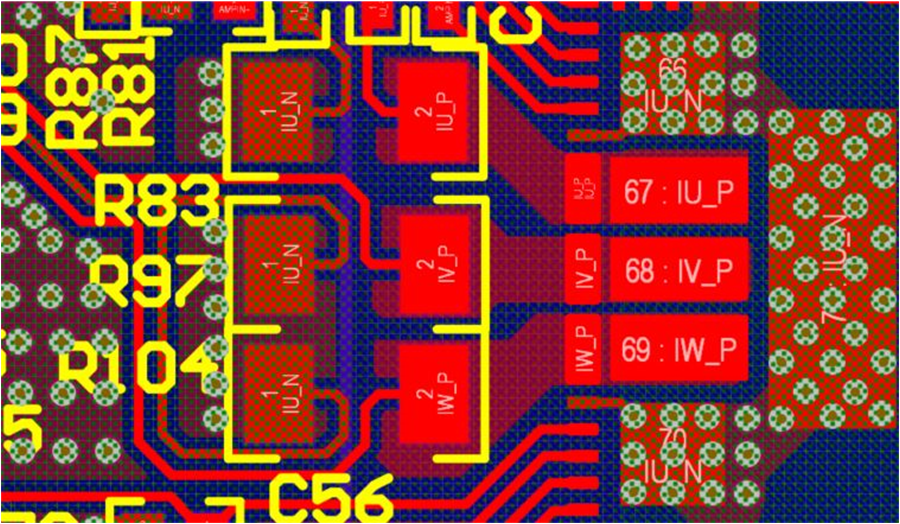TIDUF77 June 2024 MSPM0G1507
- 1
- Description
- Resources
- Features
- Applications
- 6
- 1System Description
-
2System Overview
- 2.1 Block Diagram
- 2.2 Design Considerations
- 2.3 Highlighted Products
- 2.4
System Design Theory
- 2.4.1
Hardware Design
- 2.4.1.1 Modular Design
- 2.4.1.2 Auxiliary Flyback Power Supply
- 2.4.1.3 DC Link Voltage Sensing
- 2.4.1.4 Inrush Current Protection
- 2.4.1.5 Motor Phase Voltage Sensing
- 2.4.1.6 Motor Phase Current Sensing
- 2.4.1.7 Over Current Protection of DRV7308
- 2.4.1.8 Internal Overcurrent Protection for TMS320F2800F137
- 2.4.2 Three-Phase PMSM Drive
- 2.4.1
Hardware Design
-
3Hardware, Software, Testing Requirements, and Test Results
- 3.1 Getting Started Hardware
- 3.2 Getting Started GUI
- 3.3
Getting Started C2000 Firmware
- 3.3.1 Download and Install Software Required for Board Test
- 3.3.2 Opening Project Inside CCS
- 3.3.3 Project Structure
- 3.3.4 Test Procedure
- 3.4
Test Results
- 3.4.1 Fast and clean Rising/Falling Edge
- 3.4.2 Inrush Current Protection
- 3.4.3 Thermal performance under 300VDC
- 3.4.4 Thermal performance under 220VAC
- 3.4.5 Overcurrent Protection by Internal CMPSS
- 3.4.6 IPM Efficiency with External Bias Supply under 300VDC
- 3.4.7 Board Efficiency with Onboard Bias Supply under 300VDC
- 3.4.8 Board Efficiency with External Bias Supply under 220VAC
- 3.4.9 Board Efficiency with Onboard Bias Supply under 220VAC
- 3.4.10 iTHD Test of Motor Phase Current
- 3.4.11 Standby Power Test
- 3.5 Migrate Firmware to a New Hardware Board
- 3.6 Getting Started MSPM0 Firmware
- 4Design and Documentation Support
- 5About the Author
2.4.2.4.1.2 Single-Shunt Current Sensing
The single-shunt current-sensing technique measures the DC-link bus current, with knowledge of the power FET switching states and reconstructs the three-phase current of the motor. The detailed description of the single shunt technique is described in the Sensorless-FOC for PMSM With Single DC-Link Shunt application note.
On this reference board, implement the single-shunt current-sensing technique by removing two shunts and shorting the connection of the U, V, W ground of the power module as shown in Figure 2-32.
- On the motherboard, remove current shunt resistors R97, and R104, keep only shunt resistor R83 to sense the DC-Link current.
- On TMS320F2800137 daughterboard, remove U9 and related parts and also remove C61 to increase bandwidth of internal amaplifier of DRV7308 for single-shunt sampling.
- On the MSPM0G1507 daughterboard, remove components related with internal OPA of MSPM0G1507 to increase the bandwidth for single-shunt sampling.
- Use a thick wire to connect the NU, NV, and NW pins together.

 Figure 2-32 Single-Shunt Current-Sensing Circuit for TMS320F2800137
Figure 2-32 Single-Shunt Current-Sensing Circuit for TMS320F2800137By default, the board has three shunt resistors, Figure 2-33 shows the layout of the shunt resistors. To run with a single-shunt resistor, remove R97 and R104 while keeping R83, solder IW_P, IV_P and IU_P (pin 2 of R83, R97, and R104) together, then all three phase currents flow through only R83.
 Figure 2-33 Shunt Resistors Layout
Figure 2-33 Shunt Resistors LayoutThe DC-Link current is a unidirectional signal, so the DC current offset can be set to a minimum or maximum value to improve the ADC sampling range for the DC-Link current as Figure 2-34 shows. For both daughterboards, change R79 from 20kΩ to 2.2kΩ/1% resistor for the reference voltage to have 0.327V offset for DC current sensing.
 Figure 2-34 DC Offset Reference for Single Shunt of TMS320F2800137 and MSPM0 Daughterboard
Figure 2-34 DC Offset Reference for Single Shunt of TMS320F2800137 and MSPM0 DaughterboardThe transfer function of this current sampling circuit and the calculation for single shunt are the same as the three shunts.